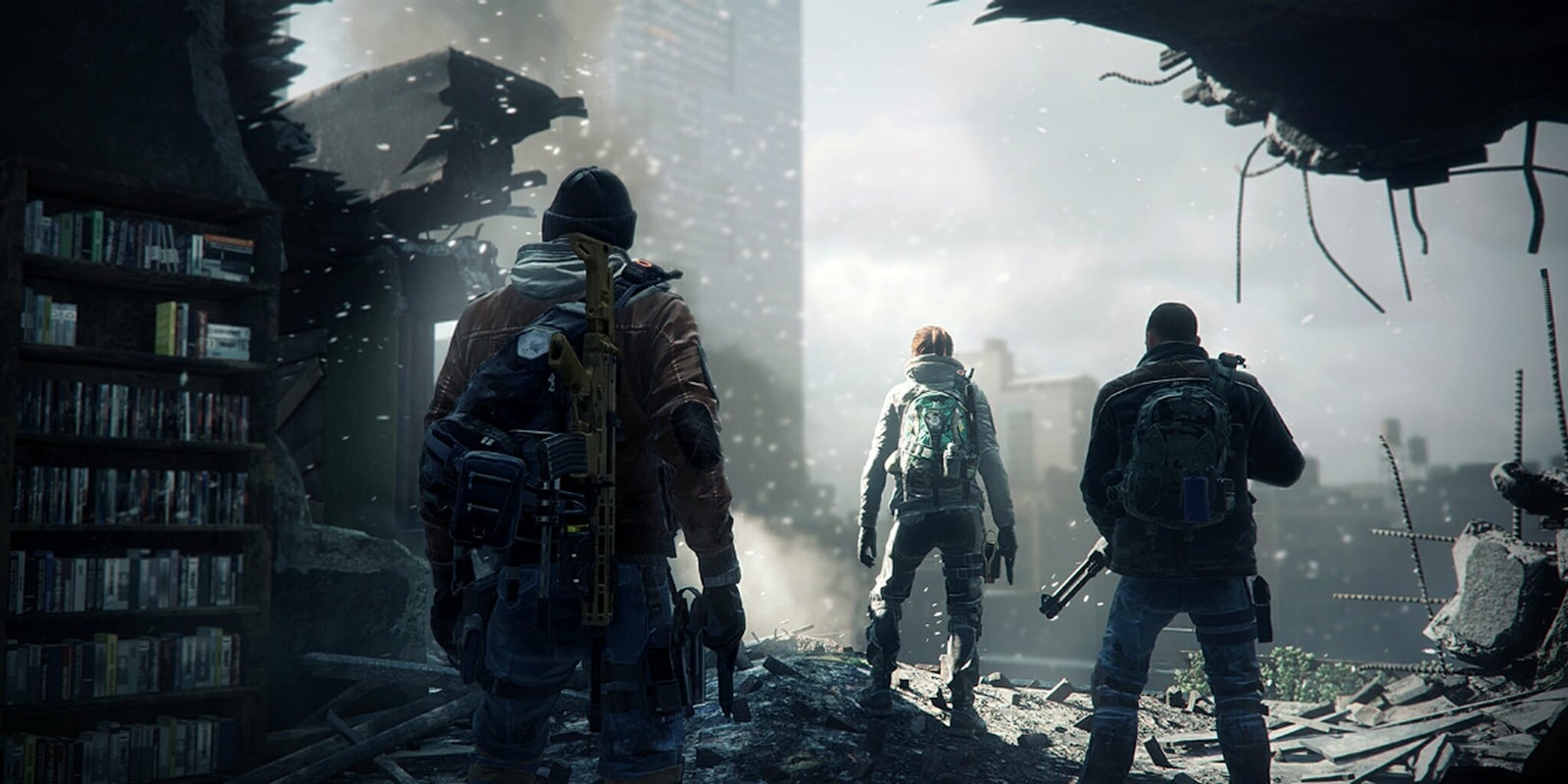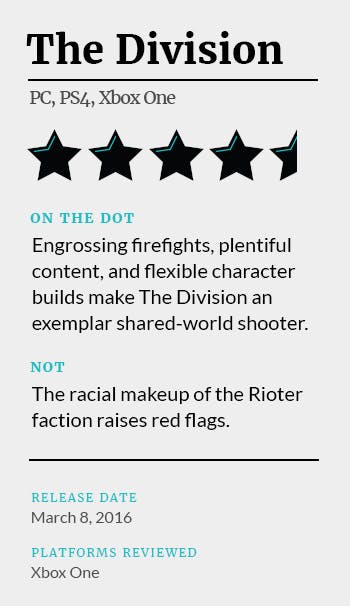A plague of weaponized smallpox has wiped out New York City. Millions of people have died. The government has fallen apart, and hunger and violence are killing the New Yorkers that the plague missed.
The Division, a network of sleeper agents embedded across America, has stepped in to hold together what little is left of society. Division agents are well-trained and highly motivated. They have access to augmented reality technology, an artificial intelligence network called ISAC, and advanced weapons and gadgets. They’re completely above the law—and you’re one of them.
Massive Entertainment wraps this premise into a technically stunning shared-world shooter that demonstrates what the genre is capable of.
Pre-release concerns about the size of the map in The Division were unfounded. For the most part you’re strictly on foot, with the exception of fast-travel locations offering easy access between neighborhoods, and any doubts about the adequacy of the play space will be allayed as soon as you attempt your first jaunt all the way across the map.
Less important than the size of the map, however, is its stunning level of artistic craftsmanship. The Division makes New York look less like a video game and more like a movie set.
Where many open-world games present large stretches of the map that are unremarkable filler, The Division is dense with tiny details that make every corner of the city interesting.
Layered on top of this immaculately constructed environment are the most impressive lighting and particle systems I’ve seen on current-generation consoles. Light rarely feels like a tactical consideration in shooter games, but in The Division I frequently found myself blinded temporarily while passing by a construction light during night patrol. When I walked out of a building into the street at high noon, my eyes took a few moments to adjust, during which I was vulnerable.
Lens flares felt organically generated from the environment, rather than forced visual tricks. The day/night cycle also felt like a slow, natural progression. And when this soft quality of the light is mixed with The Division’s particle physics, things get scary.
A snow storm markedly changes the tactical situation. Imagine a heavy snowstorm in Times Square where the snowflakes are reflecting bright, neon, purple, and blue lights while you advance, under fire, from cover to cover.
Gears of War has for years defined how smooth and accurate a cover system can and should be. The Division has done Gears one better. When you are in cover in The Division and looking around, an opaque plane is projected onto any surface where you can reposition and take cover. You hold a single button to smoothly take the new position. It works wonderfully.
Enemies in The Division use cover very well and are relentlessly aggressive. Players who can’t quickly and smartly reposition in the face of enemy assault will get slaughtered. Coordinating to suppress and flank enemies is also a must. Missions scale themselves to the number of players, and teams whose communication skills are lacking will get destroyed when the difficulty is cranked up.
What makes a team-based shooter shine is when battles are won by virtue of whether players can fight as a coherent unit. Every mission in The Division so far has provided precisely this kind of fun.
There are three levels of difficulty for missions in The Division, with the third and most challenging being unlocked when you hit the level cap of 30. Missions on Hard are punishing enough. I don’t see running missions getting old anytime soon, and when I don’t have a full group of four available, side missions all over the city are nicely balanced for two players.
Also spread throughout the city are collectible items that tell the tale of what New York was like while the spread of the virus was at its worst, and how the city fell apart before you arrived. Augmented reality recreations of past events called Echoes—still footage recovered from crashed recon drones, cell phone messages, and video files—paint an awful picture of how the city collapsed.
It’s the MMO convention The Division eschews, more than the conventions it successfully executes, that make it such an exemplar in the MMO shooter genre.
There are three trees of character development: Medical, Tech, and Security. They are tied to healing, damage dealing, and damage absorption, respectively, in yet another incarnation of the Healer/DPS/Tank Holy Trinity that has defined MMO groups since the birth of the genre.
To unlock each tree you have to earn supplies by completing main missions and short activities called Encounters that include rescuing hostages, recovering stolen supplies, or defending the Joint Task Force, a mixed unit of law enforcement and military personnel that are the backbone of surviving government authority in New York.
You spend these supplies on rebuilding the related wings inside the JTF’s headquarters. Adding new rooms unlocks new abilities and mods for those abilities. Once you have skills and mods unlocked you can switch between them at will.
Your three basic stats, Firearms, Stamina, and Electronics, that affect how much damage you do, how much damage you can take, and how strong your abilities are, respectively, are determined by corresponding stats on each piece of gear you equip. Early in the game you can unlock an expansion to the Tech wing that allows you to alter the stats on any piece of gear.
Weapons can be modded with a healthy array of scopes, magazines, and barrels. If you can’t find what you want out in the field, the crafting system in The Division is intuitive and actually produces excellent gear without you having to grind crafting skills.
The sum total of all these systems is immense freedom to change up how your character fights. If someone in your group prefers to play as a Medical specialist, so you can switch to Tech. Maybe you all select complementary sets of hybrid builds. You only need a single character to play every type of character class possible, which is not how most MMOs handle it. Typically they force you to grind out multiple characters and replay old content ad nauseum.
The way The Division handles player-versus-player content is interesting, stressful, and paranoia-inducing.
In the middle of the map is an area called the Dark Zone, walled off from the rest of the city and only accessible via airlock-like entrances. The Dark Zone has a unique form of currency that can only be spent at Dark Zone vendors, and your character has a Dark Zone experience level separate from your regular character level.
Powerful enemies show up in the Dark Zone more often than in the rest of the city. You are far more likely to run into Elites, the most powerful opponents, that also drop the best loot. The loot drops in general are much better in the Dark Zone on average than in the rest of the city.
All that loot is contaminated, however, and has to be extracted from the Dark Zone and decontaminated before you’re allowed to use it. When you launch a flare from an extraction zone it starts a countdown that everyone else in the Dark Zone can see. They also know precisely where the chopper is going to arrive.
The Dark Zone is also the only place in The Division where other players can kill you. And when you die in the Dark Zone, you drop all the Dark Zone loot you’re carrying, and lose both some Dark Zone credits and experience points.
Going into a level-appropriate sector of the Dark Zone by yourself is tantamount to suicide. The enemies are too tough, and roving gangs of other players may be too tempted not to kill and rob you.
As fun and refreshing as the Dark Zone is, it feels uncomfortably close to games like Day Z that encourage other players to grief one another. The Dark Zone is also supposed to be the only place to get the best gear in the game. I take issue with MMOs that don’t make a clean separation between player vs. environment and player vs. player content in terms of making sure both player types get access to equally good gear.
Whether or not the way the Dark Zone commanding gear quality distribution is going to be a problem in the long term is something I can only guess at. I suspect most players will warm up to the mechanics and enjoy themselves, but the Dark Zone is also going to leave some players out in the cold.
The other aspect of The Division that might grate on players is lack of variance in enemies. The Division is hamstrung in this regard, for having tied itself to a world that attempts to feel real.
The enemies are split into four factions. Rioters are the low-level enemies common in noob zones. The Cleaners are former NYC sanitation workers who’ve decided that the best way to deal with the plague is to burn it out with improvised flamethrowers. The Rikers are prison escapees who’ve stolen a mess of heavy weapons and are out for a good time.
The final faction, the Last Man Battalion, I haven’t run into yet. I’m 30 hours into the game, and I’m just now hitting the midway point in my level progression. There is a lot to do in The Division, and I’m in no hurry to rush through it all. MMOs are meant to be marathons, not sprints.
But the three factions I’ve encountered thus far share unified archetypes—melee, ranged, heavy weapons, explosive lobbers—and only the Cleaners with their flamethrowers have felt unique. The Rioters are also unique in that some people are going to find them problematic.
The rag doll physics in The Division are excellent. Most bodies fall face down or to the side, making it difficult to see a Rioter’s face. But in 90 percent of the cases where I could discern the Rioter’s race, it was a person of color.
When a game like The Division ties itself so strongly to a sense of realism, a choice like this can’t be ignored, especially not when we live a world where use of force by law enforcement against people of color is a life-and-death issue for millions of Americans.
Rioters aren’t always engaged in kidnappings and supply thefts when you encounter them, either. Sometimes a group of Rioters will just be standing around in an alley, and the expectation is that you will slaughter them on sight. In the world of The Division there are certainly no resources for jailing prisoners. Dispensing summary and capital justice goes part-and-parcel with apocalyptic scenarios. But even so, the class design choices here are unsettling.
The desire to be realistic about the violence of a post-apocalyptic police state can’t always be divorced from the nature of the times. This would seem to be one of those occasions, and I wish Massive Entertainment and Ubisoft had been more sensitive to this concern, because in most respects The Division is as excellent a shared-world shooter as I could hope for. I hope other developers working in the genre take their lead from this game.
Score: 4.5/5
Disclosure: Our Xbox One review copy of The Division was provided courtesy of Ubisoft.
Illustration via Ubisoft



